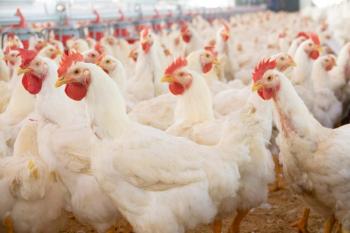
Feline leukemia virus (Proceedings)
Feline leukemia virus is endemic wherever there are free-roaming cats.
Feline leukemia virus was initially isolated from a household of cats in Scotland by Dr. Jarrett in 1964. He had been trying to determine the cause of a high incidence of lymphosarcoma in specific catteries. The AIDS epidemic has made available funding for research in both the feline leukemia virus (FeLV) and the feline immunodeficiency virus (FIV). These retrovirus studies have broadened our understanding of this group of viruses. We will discuss the pathophysiology of the disease, the spectrum of clinical presentation and the guidelines for vaccination.
Feline leukemia virus is endemic wherever there are free-roaming cats. Currently about 2 to 3% of cats that go outdoors are FeLV positive. The infection is easily spread indoors when infected cats share food and water dishes with uninfected cats. Saliva can have over 1 million viral particles per ml. Sharing litter pans can also spread the disease. The test and eliminate strategy in multi-cat households and in breeding colonies has largely eliminate the disease in strictly indoor cats. Intact male cats are especially capable distributors of the virus through fighting.
The virus produces neoplastic, immunosuppressive and bone marrow suppressive diseases. The most easily transmissible form of the virus is the FeLV-A type. The FeLV-A has little pathogenic effect but recombination with endogenous viral elements in the cat's DNA results in the production of FeLV-B which will produce tumors. A mutated form, FeLV-C, specifically targets red blood cell precursors resulting in aplastic anemic. A recently described, FeLV-T, destroys T-lymphocytes resulting in severe immunosuppression.
The most common neoplastic disease is lymphoma though any of the marrow cell lines may become neoplastic. The lymphoma may occur as leukemia or may be localized to the gut, thymus, eyes, nose, central nervous system, skin or a combination of these sites. The nature of the disease seems to be changing with intestinal lymphoma becoming more common than the multicentric or thymic forms. The thymic form is more likely to occur in young cats that are FeLV antigen positive while the gastrointestinal forms are in older cats that are FeLV antigen negative. There appears to be a relation between Helicobacter and gastric lymphoma in cats.
The non-neoplastic manifestations of FeLV infection are more common than the neoplastic diseases. The virus produces immunosuppression by gradual depletion of normal lymphocytes and depression of immune response. Feline infectious peritonitis (FIP) is much more common in households infected with FeLV. Fortunately, most breeders and multiple cat households screen for FeLV infection and remove infected cats thereby reducing their incidence of FIP. Chronic gingivitis, non-healing abscesses, mycoplasma infections (haemobartonellosis), reproductive failures and abortion and persistent upper respiratory virus infections have all been associated with FeLV infection. Suppression of bone marrow cell lines is common producing anemia and/or neutropenia. Neutropenia also contributes to the development of diseases associated with immunosuppression. Many of these syndromes also occur with FIV infection so testing should include both viruses.
The virus enters the oral cavity and initially infects the tonsils. The saliva is rich in virus and transmission has also been attributed to bite wounds from infected cats. After tonsillar infection, the virus is carried on mononuclear cells to the lymphoid tissues of the body. The virus infects the gut lymphoid tissue and replicates in the intestinal epithelium. This allows virus excretion into the stool. In the advanced stages of infection, the bone marrow is involved as is the urinary bladder. Virus is shed in the urine and in the milk of lactating queens. Virus can be spread to susceptible cats from all these sites. Young cats are especially likely to develop persistent infections. When a cat has had a transient infection and recovers from the viremia, there is probably a lifelong incorporation of proviral DNA in the genome of the cells. This DNA can be identified by PCR but these infections don't usually produce virus but may predispose to developing neoplastic conditions. These cats don't have virus in their saliva and are not a threat to other cats.
The best screening test for FeLV infection is the ELISA test. The ELISA test has been improved to eliminate operator error thereby improving the reliability of the assay. While the ELISA test is more sensitive, the indirect immunofluorescence assay (IFA) is the best marker to determine if a cat has a persistent infection. Cats that are ELISA positive may be recently infected and may clear the infection. When the infection reaches the bone marrow producing a positive IFA on blood leukocytes, cats can rarely clear the infection. Some cats will develop latent infection usually as a clearing stage of an infection. These cats are negative by ELISA and IFA but may have temporary shedding of virus in the milk producing FeLV infected kittens from FeLV virus negative queens. The PCR test can identify potential latent infections.
The development of vaccine associated fibrosarcomas after vaccination with feline leukemia virus vaccines has produced a lot of discussions about the desirability of vaccination. The incidence of tumor development appears to be about 1 cases per 10,000 vaccines given. In unvaccinated cats, 1-2% of the free roaming population will become infected. This suggests that there is a clear advantage to vaccination of cats that may be exposed to the virus. Cats appear to be genetically predisposed to develop vaccine associated sarcomas after vaccination. Any cat that has survived a vaccine associated sarcoma, should never be vaccinated again with an adjuvanted vaccine or given an injection of something that is irritating. How often should cats be revaccinated against FeLV? The duration of immunity is not known. The FeLV vaccine should be given to kittens and repeated 1 year later. Some data suggest that good immunity persist longer than a year with some of the vaccines. Adult cats are more resistant to infection than young cats. Antibody titers do not predict protection against FeLV infection. All these factors can be considered in determining the need for FeLV vaccinations.
Newsletter
From exam room tips to practice management insights, get trusted veterinary news delivered straight to your inbox—subscribe to dvm360.






